Indesit DISR 57M94 CA EU User Manual [de]

DISR 57M94
EN English
Operating instructions
DISHWASHER - Contents
Operating instructions, 1 Precautions and advice, 2-3 Product Data, 9 Assistance, 12
Installation, 13-14
Description of the appliance, 15
Refined salt and rinse aid, 16
Loading the racks, 17-18 Detergent and dishwasher use, 19 Wash cycles, 20
Special wash cycles and options, 21 Care and maintenance, 22 Troubleshooting, 23
DE Deutsch
Gebrauchsanleitung
GESCHIRRSPÜLER – Inhaltsverzeichnis
Gebrauchsanleitung, 1 Vorsichtsmaßnahmen und Hinweise, 3-4 Produktdatenblatt, 9
Kundendienst, 12
Installation, 24-25
Beschreibung Ihres Geschirrspülers, 26 Regeneriersalz und Klarspüler, 27 Beladen der Körbe, 28-29
Spülmittel und Verwendung des Geschirrspülers, 30 Programme, 31
Sonderprogramme und Optionen, 32 Reinigung und Pflege, 33
Störungen und Abhilfe, 34
PL Polski
Instrukcja obsługi
ZMYWARKA - Spis treści
Instrukcja obsługi, 1
Zalecenia i środki ostrożności, 4-5
Karta produktu, 10 Serwis Techniczny, 12
Instalacja, 35-36 Opis urządzenia, 37
Sól regeneracyjna i środek nabłyszczający, 38 Ładowanie koszy, 39-40
Środek myjący i obsługa zmywarki, 41
Programy, 42
Programy specjalne i opcje, 43 Konserwacja i obsługa, 44
Nieprawidłowe działanie i możliwe środki zaradcze, 45
CS Česky
Návod k použití
MYČKA NÁDOBÍ -Obsah
Návod k použití, 1 Opatření a rady, 5-6-7 Informační list výrobku, 10 Servisní služba, 12 Instalace, 46-47
Popis zařízení, 48 Regenerační sůl a Leštidlo, 49 Plnění košů, 50-51
Mycí prostředek a použití myčky, 52
Programy, 53
Speciální programy a Volitelné funkce, 54 Údržba a péče, 55
Poruchy a způsob jejich odstranění, 56
SK Slovensky
Návod na použitie
UMÝVAČKA RIADU - Obsah
Návod na použitie, 1
Opatrenia a rady, 7-8
Opis výrobku, 11 Servisná služba, 12 Inštalácia, 57-58
Popis zariadenia, 59
Regeneračná soľ a Leštidlo, 60 Naplňte koše, 61-62
Umývací prostriedok a použitie umývačky, 63 Programy, 64
Špeciálne programy a Voliteľné funkcie, 65 Údržba a starostlivosť, 66
Poruchy a spôsob ich odstránenia, 67
1

EN Precautions and advice
 This appliance was designed and manufactured in compliance with international safetystandards.Thefollowinginformationhas been provided for safety reasons and should be read carefully.
This appliance was designed and manufactured in compliance with international safetystandards.Thefollowinginformationhas been provided for safety reasons and should be read carefully.
Keep this instruction manual in a safe place for future reference. If the appliance is sold, given away or moved, make sure the manual is kept with the machine.
Read the instructions carefully, as they include important information on safe installation, use and maintenance.
This appliance was designed for domestic use or similar applications, for example:
- farmhouses;
- use by guests in hotels, motels and other residential settings;
- bed & breakfasts.
Remove the appliance from all packaging and make sure it was not damaged during transportation. If it was damaged, contact the retailer and do not proceed any further with the installation process.
General safety
• This appliance should not be operated by children younger than 8 years, people with reduced physical, sensory or mental capacities, or inexperienced people who are not familiar with the product, unless they aregivenclosesupervisionorinstructionson how to use it safely and are made aware by a responsible person of the dangers its use might entail.
• Children must not play with the appliance.
• It is the user's responsibility to clean and maintain the appliance. Children should never clean or maintain it unless they are given supervision.
• The appliance was designed for domestic use inside the home and is not intended for commercial or industrial use.
• The appliance must be used to wash domestic crockery in accordance with the instructions in this manual.
• Theappliancemustnotbeinstalledoutdoors, even in covered areas. It is extremely dangerous to leave the machine exposed to rain and storms.
• Do not touch the appliance when barefoot.
• When unplugging the appliance always pull the plug from the mains socket. Do not pull
on the cable.
• Thewatersupplytapmustbeshutoffandthe plug should be removed from the electrical socket at the end of every cycle and before cleaning the appliance or carrying out any maintenance work.
• The maximum number of place settings is shown in the product sheet.
• If the appliance breaks down, do not under anycircumstancestouchtheinternalpartsin anattempttoperformtherepairworkyourself.
• Do not lean or sit on the open door: this may cause the appliance to overturn.
• The door should not be left open as it may create a dangerous obstacle.
• Keep detergent and rinse aid out of reach of children.
• The packaging material should not be used as a toy.
• Knives and other utensils with sharp edges must be placed either with the points/blades facing downwards in the cutlery basket or horizontally on the tip-up compartments or in the tray/third basket, if available.
• Connect the appliance to the water mains using the new supply hose provided with the appliance. Do not re-use the old hose.
• Install the back side of a free-standing dishwasher against a wall.
Disposal
• Todisposeofanypackagingmaterials,follow local legislation so that the packagings may be reused.
• The European Directive 2012/19/EU relating toWasteElectricalandElectronicEquipment (WEEE) states that household appliances should not be disposed of using the normal solid urban waste cycle. Exhausted appliances should be collected separately in order to optimise the cost of reusing and recycling the materials inside the machine, while preventing potential damage to the atmosphereandpublichealth.Thecrossedout dustbin symbol shown on all products reminds the owners of their obligations regarding separated waste collection.
For further information relating to the correct disposal of household appliances, owners may contact the relevant public authority or the local appliance dealer.
Saving energy and respecting the environment
Saving water and energy
• Onlybeginawashcyclewhenthedishwasher is full. While waiting for the dishwasher to be
2

filled, prevent unpleasant odours with the
Soak cycle (if available, see Wash Cycles).
• Selectawashcyclethatissuitedtothetypeof
crockery and to the soil level using the Table
of Wash Cycles:
- For dishes with a normal soil level, use the Eco wash cycle, which guarantees low energy and water consumption levels.
- If the load is smaller than usual activate
the Half Load option (see Special wash cycles and
options, if available).
• Ifyourelectricitysupplycontractgivesdetails ofelectricity-savingtimebands,runthewash cycles when electricity prices are lower. The
Delayed Start option can help you organise the wash cycles accordingly (see Special wash
cycles and options, if available).
DE VorsichtsmaßnahmenHinweise und
 Das Gerät wurde nach den strengsten internationalen Sicherheitsvorschriften konzipiert und hergestellt. Nachstehende Hinweise werden aus Sicherheitsgründen angegeben und sollten aufmerksam gelesen werden.
Das Gerät wurde nach den strengsten internationalen Sicherheitsvorschriften konzipiert und hergestellt. Nachstehende Hinweise werden aus Sicherheitsgründen angegeben und sollten aufmerksam gelesen werden.
Bewahren Sie diese Bedienungsanleitung sorgfältig auf, damit Sie sie jederzeit zu Rate ziehen können. Im Falle eines Verkaufs, einer
Übergabe oder eines Umzugs muss sie dem Gerät stets beiliegen.
Lesen Sie die folgenden Hinweise aufmerksam durch, denn sie liefern wichtige Informationen hinsichtlich der Installation, des Gebrauchs und der Sicherheit.
Dieses Gerät wurde für den Hausgebrauch oder ähnliche Anwendungen konzipiert, zum
Beispiel:
- Bauernhäuser
- Nutzung durch Kunden in Hotels, Motels und anderen Wohnbereichen
- Frühstückspensionen
Nehmen Sie das Verpackungsmaterial ab und prüfen Sie Ihr Gerät auf eventuelle Transportschäden. Schließen Sie das Gerät im Falle einer Beschädigung bitte nicht an, sondern fordern Sie den Kundendienst an.
Allgemeine Sicherheit
• Dieses Haushaltsgerät darf von Kindern ab acht Jahren und von Personen mit eingeschränkten körperlichen, s e n s o r i s c h e n o d e r g e i s t i g e n
Fähigkeiten oder ohne Erfahrung und
der notwendigen Kenntnis verwendet werden, vorausgesetzt, sie werden streng von einer verantwortungsbewussten Person überwacht oder sie haben eine ausreichende Einweisung in die sichere Nutzung des Geräts erhalten und die damit verbundenen Gefahren verstanden.
• Kinder dürfen nicht mit dem Gerät spielen.
• Die Reinigung und die Wartung des Geräts müssen vom Benutzer ausgeführt werden. Diese Arbeiten dürfen nicht von unbeaufsichtigten Kindern ausgeführt werden.
• DiesesGerätistfürdennichtprofessionellen
Einsatz in privaten Haushalten bestimmt.
• Das Gerät darf nur zum Spülen von Haushaltsgeschirr und gemäß den Anleitungen dieses Handbuchs verwendet werden.
• Das Gerät darf nicht im Freien aufgestellt werden, auch nicht, wenn es sich um einen geschützten Platz handelt. Es ist äußerst gefährlich, das Gerät Regen und Gewittern auszusetzen.
• Berühren Sie den Geschirrspüler nicht, wenn Sie barfuß sind.
• Ziehen Sie den Netzstecker nicht am
Netzkabel aus der Steckdose, sondern nur am Netzstecker selbst.
• Vor Reinigungsund Wartungsarbeiten mussamEndejedesZyklusderWasserhahn zugedreht und der Netzstecker aus der Steckdose gezogen werden.
• Die höchstzulässige Anzahl an Gedecken
ist auf dem Produktdatenblatt angegeben.
• Versuchen Sie bei etwaigen Störungen keinesfalls, Innenteile selbst zu reparieren.
• Stützen Sie sich und setzen Sie sich nicht auf die offen stehende Gerätetür; das Gerät könnte umkippen.
• Die Gerätetür sollte nicht offen gelassen werden, da man darüber stolpern könnte.
• Bewahren Sie das Spülmittel und den Klarspüler außerhalb der Reichweite von
Kindern auf.
• Verpackungsmaterial ist kein Spielzeug für
Kinder.
• Messer und anderes Besteck mit scharfen
Kanten müssen mit der Spitze/Klinge nach unten in den Besteckkorb gegeben oder horizontal auf die Klappfächer oder auf das
Tablett/den dritten Korb gelegt werden, sofern dies bei Ihrem Modell vorhanden ist.
• Das Gerät wird mit dem neuen Versorgungsschlauch an das Wassernetz angeschlossen und der alte Schlauch darf
3

nicht mehr verwendet werden.
Handelt es sich bei der Spülmaschine um ein frei stehendes Gerät, muss die Rückseite an eine Wand gestellt werden.
Entsorgung
• Befolgen Sie die lokalen Vorschriften;
Verpackungsmaterialkannwiederverwertet werden.
• Die europäische Richtlinie 2012/19/EG über Elektround Elektronik-Altgeräte (WEEE) sieht vor, dass Haushaltsgeräte nicht mit dem normalen Hausmüll entsorgt werden dürfen. Die Altgeräte müssen getrennt gesammelt werden, um die Rückführung und das Recycling der Materialen zu optimieren, aus denen die Geräte hergestellt sind, und um mögliche Belastungen der Gesundheit und der Umwelt zu verhindern. Das
Mülleimersymbol ist auf allen Produkten dargestellt, um an die Verpflichtung zur getrennten Abfallsammlung zu erinnern.
Für weitere Informationen hinsichtlich der ordnungsgemäßen Entsorgung von Haushaltsgeräten wenden Sie sich bitte an Ihren Händler oder an die zuständige kommunale Stelle.
Energie sparen und Umwelt schonen
Wasser und Strom sparen
• Setzen Sie den Geschirrspüler nur bei voller Ladung in Betrieb. Um in der Zwischenzeit, d. h. bis das Gerät ganz gefüllt ist, die Bildung unangenehmer
Gerüche zu vermeiden, setzen Sie den Einweichzyklus in Gang (sofern verfügbar –
siehe Spülprogramme).
• Wählen Sie ein für das zu spülende Geschirr und den Verschmutzungsgrad geeignetes Programm. Ziehen Sie hierzu die Programmtabelle zu Rate:
- Verwenden Sie für normal verschmutztes
Geschirr das umweltfreundliche Sparprogramm Eco, das einen niedrigen Wasserund Stromverbrauch gewährleistet.
- Aktivieren Sie bei geringfügiger Beschickung die Option Halbe Füllung
(sofern verfügbar – siehe Sonderprogramme und
Optionen).
• SiehtIhrStromliefervertragBilligstromzeiten vor, empfiehlt sich, das Gerät in diesen Zeiten in Betrieb zu setzen. Die Option
Verzögerter Start kann dabei helfen, die
Spülgänge entsprechend zu organisieren
(sofern verfügbar – siehe Sonderprogramme und
Optionen).
PL Zaleceniaiśrodkiostrożności
 Niniejsze urządzenie zostało zaprojektowane i wyprodukowane zgodnie z m i ę d z y n a r o d o w y m i n o r m a m i bezpieczeństwa. Poniższe ostrzeżenia podanezostałyzewzględówbezpieczeństwa i należy je uważnie przeczytać.
Niniejsze urządzenie zostało zaprojektowane i wyprodukowane zgodnie z m i ę d z y n a r o d o w y m i n o r m a m i bezpieczeństwa. Poniższe ostrzeżenia podanezostałyzewzględówbezpieczeństwa i należy je uważnie przeczytać.
Należy zachować niniejszą książeczkę instrukcji dla przyszłych konsultacji. W przypadku sprzedaży, odstąpienia lub przeprowadzki należy dopilnować, aby została przekazana wraz z urządzeniem nowemu właścicielowi.
Uważnie przeczytać instrukcję: zawiera ona ważne informacje dotyczące instalacji, użytkowania i bezpieczeństwa.
To urządzenie zostało zaprojektowane do użytku domowego lub podobnych zastosowań, na przykład:
- w domach kolonijnych;
-doużytkuprzezklientówwhotelach,motelach i innych obiektach typu mieszkaniowego;
- w pensjonatach bed and breakfast.
Rozpakować urządzenie i sprawdzić, czy nie zostałouszkodzonepodczastransportu.Jeśli okazałoby się uszkodzone, nie podłączać go, lecz skontaktować się ze sprzedawcą.
Bezpieczeństwo ogólne
• Niniejsze urządzenie może być używane przez dzieci powyżej 8 roku życia oraz osoby o ograniczonych zdolnościach fizycznych, zmysłowych i umysłowych lub nie posiadające jego odpowiedniej znajomości lub doświadczenia, pod warunkiem, że znajdują się one pod ścisłym nadzorem odpowiedzialnej za nie osoby bądź też otrzymały instrukcje dotyczące bezpiecznego użytkowania urządzenia oraz zrozumiały związane z nim zagrożenia.
• Dzieci nie powinny bawić się urządzeniem.
• Czyszczenie oraz konserwację urządzenia musiprzeprowadzaćużytkownik.Niemogą być one przeprowadzane przez dzieci bez nadzoru.
• Urządzenie jest przeznaczone do użytku nieprofesjonalnegowewnątrzpomieszczeń mieszkalnych.
• Urządzenie powinno być używane do
4

mycia naczyń w warunkach domowych zgodnie z niniejszymi instrukcjami.
• Urządzenia nie należy instalować na świeżym powietrzu, nawet w miejscu zadaszonym, gdyż wystawienie go na działanie deszczu i burz jest bardzo niebezpieczne.
• Nie dotykać zmywarki, stojąc boso na podłodze.
• Przy wyjmowaniu wtyczki z gniazdka nie ciągnąć za kabel, lecz trzymać za wtyczkę.
• Po zakończeniu każdego cyklu i przed przystąpieniem do czyszczenia i konserwacji urządzenia należy zamknąć zawór wody i wyjąć wtyczkę z gniazdka.
• Maksymalna ilość nakryć jest podana w karcie produktu.
• W razie uszkodzenia w żadnym wypadku nie ingerować w wewnętrzne mechanizmy urządzenia iniepróbować gosamodzielnie naprawiać.
• Nie opierać się ani nie siadać na otwartych drzwiach: urządzenie mogłoby się przewrócić.
• Nie należy pozostawiać otwartych drzwi zmywarki, gdyż można się o nie potknąć.
• Trzymać detergenty i płyn nabłyszczający z dala od dzieci.
• Opakowania nie są zabawkami dla dzieci.
• Noże i przyrządy o ostrych krawędziach należy wkładać do kosza na sztućce, tak aby czubki/ostrza były skierowane do dołu, lub układać w położeniu poziomym na półeczkach lub na tacy/trzecim koszu w modelach,wktórychsąonezainstalowane.
• Należy podłączyć urządzenie do sieci wodnej, stosując nowy przewód doprowadzający wodę; nie należy używać starego przewodu.
• Podczas ustawiania zmywarek wolnostojących, tylna część musi być zwrócona w kierunku ściany.
Utylizacja
• Utylizacja materiałów opakowaniowych: dostosować się do lokalnych przepisów; w ten sposób opakowanie będzie mogło zostać ponownie wykorzystane.
• Dyrektywa wspólnotowa 2012/19/EU w sprawie zużytego sprzętu elektrycznego i elektronicznego (WEEE) przewiduje, że sprzęt gospodarstwa domowego nie powinienbyćusuwanyjakonieposortowane odpady komunalne. Zużyte urządzenia powinny podlegać selektywnej zbiórce w celu uzyskania maksymalnego wskaźnika
odzysku i recyklingu ich materiałów składowych oraz uniknięcia ewentualnych zagrożeńdlazdrowiai środowiska.Symbol przekreślonego kosza umieszczany jest na wszystkich produktach w celu przypominania o obowiązku segregacji odpadów.
W celu uzyskania bliższych informacji na temat prawidłowego złomowania urządzeń gospodarstwa domowego ich właściciele mogą się zwrócić do właściwych służb publicznych lub do sprzedawców tych urządzeń.
Oszczędność i ochrona środowiska
Oszczędność wody i energii
• Uruchamiać zmywarkę tylko z pełnym ładunkiem. W oczekiwaniu na napełnienie maszyny zapobiegać przykrym zapachom przy pomocy cyklu namaczania (jeśli jest on
dostępny - zob. Programy).
• Wybierać programy odpowiednie do rodzaju naczyń i stopnia zabrudzenia, stosując się do Tabeli programów:
- dla naczyń normalnie zabrudzonych stosować program Eco, który zapewnia niskie zużycie energii i wody.
-przyograniczonymładunkuwłączyćopcję
Połowa ładunku (jeśli jest on dostępny - zob.
Programy specjalne i opcje).
• Jeśli zawarta umowa na dostawę energii elektrycznej przewiduje strefy czasowe oszczędności energetycznej, uruchamiać zmywarkę w godzinach obowiązywania niższej taryfy. Opcja Opóźnienia startu możepomocwtakiejorganizacjizmywania
(jeśli jest ona dostępny - zob. Programy specjalne i opcje).
CS Opatření a rady
 Zařízení bylo navrženo a vyrobeno v souladu s platnými mezinárodními bezpečnostními předpisy. Tato upozornění jsou uváděna z bezpečnostních důvodů a je třeba si je pozorně přečíst.
Zařízení bylo navrženo a vyrobeno v souladu s platnými mezinárodními bezpečnostními předpisy. Tato upozornění jsou uváděna z bezpečnostních důvodů a je třeba si je pozorně přečíst.
Je velmi důležité tento návod uschovat, aby jej bylo možné kdykoli dle potřeby konzultovat. V případě prodeje, darování nebo přestěhování zařízení se ujistěte, že návod zůstane uložen v jeho blízkosti.
Pozorně si přečtěte uvedené pokyny: Obsahují důležité informace o instalaci, použití a bezpečnosti.
5

Toto zařízení bylo navrženo pro použití v domácnosti nebo pro podobné aplikace, jako například:
- hospodářská stavení;
- použití zákazníky v hotelu, motelu nebo jiných prostředích rezidenčního typu;
- penziony typu „bed and breakfast“.
Po rozbalení zařízení zkontroluje, zda během přepravy nedošlo kjeho poškození. V případě, že je poškozeno, je nezapojujte a obraťte se na prodejce.
Základní bezpečnostní pokyny
• Tento elektrospotřebič mohou používat děti ve věku od 8 let a osoby se sníženými fyzickými, senzorickými nebo duševními schopnostmi nebo osoby bez zkušeností nebo potřebné znalosti, když jsou pod dozorem odpovědné osoby, případně poté, co jim byly poskytnuty pokyny týkající se bezpečného použití zařízení a pochopení souvisejících nebezpečí.
• Děti si nesmí hrát se zařízením.
• Čištění a údržbu zařízení musí provádět uživatel. Nesmí je provádět děti bez dozoru.
• Toto zařízení bylo navrženo výhradně pro neprofesionální použití v domácnosti.
• Zařízení musí být používání na mytí nádobí v domácnosti podle pokynů uvedených v tomto návodu.
• Zařízení nesmí být nainstalováno venku, a to ani v případě, že by se jednalo o místo chráněné před nepřízní počasí, protože je velmi nebezpečné vystavit jej působení deště a bouří.
• Nedotýkejte se myčky nádobí bosýma nohama.
• Nevytahujte zástrčku ze zásuvky elektrického rozvodu tahem za kabel, ale uchopením za zástrčku.
• Na konci každého cyklu a před provedením operací čištění a údržby je třeba zavřít kohoutek přívodu vody a odpojit zástrčku ze zásuvky elektrického rozvodu.
• Maximální počet jídelních souprav je uveden v technickém listu výrobku.
• Při výskytu poruchy se vžádném případě nepokoušejte o opravu vnitřních částí zařízení.
• Neopírejte se o otevřená dvířka a nesedejte si na ně: zařízení by se mohlo převrátit.
•Dvířka nesmí zůstat v otevřené poloze, protožebymohlapředstavovatnebezpečí zakopnutí.
•Udržujte mycí prostředek a leštidlo mimo dosah dětí.
•Obaly nejsou hračky pro děti!
•Nože a nástroje s ostrými hroty musí být umístěny do košíku na příbory s hroty/ ostřími obrácenými směrem dolů nebo do vodorovné polohy na sklopné držáky nebo na tác/do třetího koše u modelů, jejichž je součástí.
•Zařízení musí být připojeno k rozvodu vody novou přívodní hadicí a stará přívodní hadice nesmí být znovu použita.
•Když se jedná o volně instalovatelnou myčku nádobí, její zadní strana musí být umístěna ke stěně.
Likvidace
• Likvidace obalových materiálů: Při jejich odstraňování postupujte v souladu s místním předpisy a dbejte na možnou recyklaci.
• Evropskásměrnice2012/19/EUoodpadu tvořeném elektrickými a elektronickými zařízeními (RAEE) předpokládá, že elektrospotřebiče nesmí být likvidovány v rámci běžného pevného městského odpadu. Vyřazená zařízení musí být sesbírána zvlášť za účelem zvýšení počtu recyklovaných a znovu použitých materiálů, ze kterých jsou složena, a za účelem zabránění možným ublížením na zdraví a škodám na životním prostředí. Symbolem je přeškrtnutý koš, který je uveden na všech výrobcích s cílem připomenout povinnosti spojené se separovaným sběrem.
Podrobnější informace týkající se správného způsobu vyřazení elektrospotřebičů z provozu mohou jejich držitelé získat tak, že se obrátí na navrženou veřejnou instituci nebo na prodejce.
Jak ušetřit a brát ohled na životní prostředí
Šetření vodou a energií
• Uvádějte myčku nádobí do chodu pouze tehdy, když je naplněna. Během čekání na naplnění zařízení zabraňte vzniku nepříjemného zápachu použitím cyklu
Namáčení (je-li součástí - viz Programy).
• Zvolte program vhodný pro druh nádobí a stupeň znečištění; podívejte se do
6

Tabulky programů:
- pro běžně znečištěné nádobí použijte program Eko, který zaručuje nízkou spotřebu energie a vody.
- při menším množství nádobí použijte volitelnou funkci Poloviční náplň (je-li
součástí -viz Speciální programy a Volitelné funkce).
• V případě, že vaše smlouva na dodávku elektrické energie předpokládá používání časových pásem pro šetření elektrickou energií, provádějte mytí v časových pásmech se sníženou sazbou. Volitelná funkce Odložený start může napomoci organizaci mycích cyklů uvedeným
způsobem (je-li součástí -viz Speciální programy a Volitelné funkce).
SK Opatrenia a rady
 Zariadenie bolo navrhnuté a vyrobené vsúladesmedzinárodnýmibezpečnostnými normami. Tieto upozornenia sú uvádzané z bezpečnostných dôvodov a je potrebné si ich pozorne prečítať.
Zariadenie bolo navrhnuté a vyrobené vsúladesmedzinárodnýmibezpečnostnými normami. Tieto upozornenia sú uvádzané z bezpečnostných dôvodov a je potrebné si ich pozorne prečítať.
Je dôležité tento návod uschovať, kvôli prípadnému neskoršiemu nahliadnutiu. V prípade predaja, darovania alebo presťahovania zariadenia zabezpečte, aby návod zostal vždy jeho súčasťou.
Pozorne si prečítajte uvedené pokyny: Sú zdrojom dôležitých informácií, týkajúcich sa inštalácie, použitia a bezpečnosti.
Toto zariadenie bolo navrhnuté pre použitie v domácnosti alebo pre podobné aplikácie, ako napríklad:
- hospodárske príbytky;
- použitie zákazníkmi v hoteli, moteli alebo iných rezidenčných zariadeniach;
- penzióny typu „bed and breakfast“.
Po rozbalení zariadenia skontrolujte, či počas prepravy nedošlo kjeho poškodeniu. Ak je poškodené, nezapájajte ho a obráťte sa na predajcu.
Základné bezpečnostné pokyny
• Tento elektrospotrebič smú používať deti vo veku do 8 rokov a osoby so zníženými fyzickými, zmyslovými alebo duševnými schopnosťami, alebo osoby bez skúseností alebo potrebných znalostí, len
ak sú pod dozorom zodpovednej osoby, alebo ak boli poučení o bezpečnom použitízariadeniaaakpochopilisúvisiace nebezpečenstvá.
• Deti sa so zariadením nesmú hrať.
• Čistenie a údržbu zariadenia musí vykonávať užívateľ. Túto činnosť nesmú vykonávať deti bez dozoru.
• Toto zariadenie bolo navrhnuté pre neprofesionálne použitie vo vnútri bytu/ domu.
• Zariadenie musí byť používané na umývanie riadu v domácnosti, podľa pokynov uvedených v tomto návode.
• Zariadenie nesmie byť nainštalované v exteriéri, a to ani v prípade, keď sa jedná o chránený priestor, pretože jeho vystavenie dažďu alebo búrke je mimoriadne nebezpečné.
• Nedotýkajte sa umývačky riadu bosými nohami.
• Nevyťahujte zástrčku zo zásuvky elektrickej siete ťahaním za kábel, ale uchopením za zástrčku.
• Na konci každého cyklu pred čistením a údržbou je potrebné zatvoriť kohútik prívodu vody a odpojiť zástrčku zo zásuvky elektrického rozvodu.
• Maximálny počet jedálenských súprav je uvedený v technickom liste výrobku.
• V prípade poruchy sa v žiadnom prípade nepokúšajte zasahovať do vnútorných častí, v snahe o opravu.
• Neopierajte sa o otvorené dvierka a nesadajte si na ne: zariadenie by sa mohlo prevrátiť.
• Nenechávajte dvierka otvorené, pretože by ste mohli o ne zakopnúť.
• Udržujte umývací prostriedok a leštidlo mimo dosahu detí.
• Obaly nie sú hračky pre deti!
• Nože a náradie s ostrými hrotmi musia byť uložené do košíka na príbory hrotmi/ ostrím obráteným smerom dolu, alebo musia byť uložené do vodorovnej polohy na sklopné držiaky alebo na podnos/do tretieho koša, ak je súčasťou daného modelu.
• Zariadenie musí byť pripojené k rozvodu vody novou prívodnou hadicou a stará prívodná hadica nesmie byť opätovne použitá.
7

•Ak sa jedná o voľne inštalovateľnú umývačku riadu, jej zadná strana musí byť umiestnená ku stene.
Likvidácia
• Likvidácia obalových materiálov: Obaly zlikvidujte vsúlade smiestnymi predpismi kvôli umožneniu ich recyklácie.
• Európskasmernica2012/19/EUoodpade z elektrických a elektronických zariadení (OEEZ) predpisuje, že elektrospotrebiče nesmú byť zlikvidované v rámci bežného tuhého komunálneho odpadu. Vyradené zariadenia musia byť zozbierané separovane kvôli optimalizácii stupňa opätovného použitia a recyklácie materiálov, z ktorých sú vyrobené, a kvôli zamedzeniu možných škôd na zdraví a na životnom prostredí. Symbol preškrtnutého koša, uvedený na všetkých takýchto výrobkoch, upozorňuje na povinnosti spojené so separovaným zberom.
Podrobnejšie informácie, týkajúce sa správneho spôsobu vyradenia elektrospotrebičov z prevádzky, môžu ich držitelia získať od poverenej verejnej inštitúcie alebo od predajcu.
Ako ušetriť a brať ohľad na životné prostredie
Šetrenie vodou a energiou
• Používajte umývačku riadu len vtedy, keď je naplnená. Počas čakania na naplnenie zariadenia zabráňte vzniku nepríjemného zápachu spustením cyklu
Namáčania (ak je súčasťou - viď Programy).
• Zvoľte program vhodný pre druh riadu a stupeň znečistenia podľa Tabuľky programov:
- pre bežné znečistenie riadu použite program Eko, ktorý zaručuje nízku spotrebu energie a vody.
- pri menšom množstve riadu použite voliteľnú funkciu Polovičná náplň (ak
je súčasťou - viď Špeciálne programy a Voliteľné
funkcie).
• V prípade dodávky elektrickej energie v časových pásmach pre šetrenie elektrickou energiou, používajte umývačku v časových pásmach so zníženou sadzbou. Voliteľná funkcia
Oneskorený štart vám umožní používať umývačku práve v tomto čase (ak je
súčasťou - viď Špeciálne programy a Voliteľné funkcie).
8

EN Product Data (product fiche)
Product Fiche
Brand |
INDESIT |
Model |
DISR 57M94 |
Rated capacity in standard place settings (1) |
10 |
Energy efficiency class on a scale from A+++ (low consumption) to D (high consumption) |
A++ |
Energy consumption per year in kWh (2) |
211 |
Energy consumption of the standard cleaning cycle in kWh |
0.74 |
Power consumption of the off-mode in W |
0.5 |
Power consumption of the left-on mode in W |
5.0 |
Water consumption per year in litres (3) |
2520 |
Drying efficacy class on a scale from G (low efficacy) to A (high efficacy) |
A |
Programme time for standard cleaning cycle in minutes |
180 |
The duration of the left-on mode in minutes |
12 |
Noise in dB(A) Re 1pW |
44 |
Built-in model |
Yes |
NOTES
1) The information on the label and fiche relates to the standard cleaning cycle, this programme is suitable to clean normally soiled tableware and it is the most efficient programme in terms of combined energy and water consumption. The standard cleaning cycle corresponds to the Eco cycle.
2) Based on 280 standard cleaning cycles using cold water fill and the consumption of the low power modes. Actual energy consumption depends on how the appliance is used.
3) Based on 280 standard cleaning cycles. Actual water consumption depends on how the appliance is used.
DE Datenblatt
Datenblatt
Marke |
INDESIT |
Modell |
DISR 57M94 |
Nennkapazität in Standardgedecken für den Standardreinigungszyklus (1) |
10 |
Energieeffizienzklasse (A+++ niedriger Verbrauch) bis D (hoher Verbrauch) |
A++ |
Energieverbrauch pro Jahr in kWh (2) |
211 |
Energieverbrauch Standardreinigungszyklus in kWh |
0.74 |
Gewichtete Leistungsaufnahme im Aus-Zustand in W |
0.5 |
Gewichtete Leistungsaufnahme im unausgeschalteten Zustand in W |
5.0 |
Wasserverbrauch pro Jahr in Liter (3) |
2520 |
Trocknungseffizienzklasse (A höchste Effizienz) bis G (geringste Effizienz) |
A |
Programmdauer des Standardreinigungszyklus in Minuten |
180 |
Dauer des unausgeschalteten Zustands nach Programmende |
12 |
Luftschallemissionen dB(A) re 1pW |
44 |
Einbaugerät |
Ja |
HINWEIS |
|
1) Angabe auf Grundlage von 280 Standardreingungszyklen bei Kaltwasserbefüllung und dem Verbrauch der Betriebsarten mit geringer Leistungsaufnahme. Der tatsächliche Energieverbrauch hängt von der Art der Nutzung des Geräts ab.
2) Die Angaben beziehen sich auf den Standardreinigungszyklus. Dieses Programm eignet sich zur Reingung von normal verschmutztem Geschirr und ist am effizientesten in Bezug auf den kombinierten Energieund Wasserverbrauch. Der Standardreingungszyklus entspricht dem Eco Zyklus.
3) Angabe auf Grundlage von 280 Standardreingungszyklen. Der tatsächliche Energieverbrauch hängt von der Art der Nutzung des Geräts ab.
9

PL Karta produktu
Karta produktu
Marka |
INDESIT |
Nazwa modelu |
DISR 57M94 |
Pojemność znamionowa, wyrażona liczbą standardowych kompletów naczyń (1) |
10 |
Klasa efektywności energetycznej, skala od A+++ (niskie zużycie) do D (wysokie zużycie) |
A++ |
Zużycie energii w kWh rocznie (2) |
211 |
Zużycie energii w standardowym cyklu zmywania w kWh |
0.74 |
Zużycie energii w trybie wyłączenia i trybie czuwania w W |
0.5 |
Zużycie energii w trybie włączenia i trybie czuwania w W |
5.0 |
Roczne zużycie wody w litrach rocznie (3) |
2520 |
Klasa efektywności suszenia, skala od G (minimalna efektywność) do A (maksymalna efektywność) |
A |
Czas programu dla standardowego cyklu zmywania w minutach |
180 |
Czas trwania trybu czuwania w minutach |
12 |
Poziom emitowanego hałasu w dB(A) re1 pW |
44 |
Model do zabudowy |
Tak |
Uwagi |
|
1) Informacja, że cykl jest odpowiedni do zmywania normalnie zabrudzonych zastaw stołowych oraz że jest najbardziej efektywnym programem pod względem łącznego zużycia energii i wody dla tego rodzaju zastawy stołowej; Standardowy cykl zmywania odpowiada cyklowi Eco.
2) Na podstawie 280 standardowych cykli zmywania, przy użyciu zimnej wody, oraz w trybie niskiego zużycia energii. Rzeczywiste zużycie energii zależy od sposobu użycia urządzenia.
3) Na podstawie 280 standardowych cykli zmywania. Rzeczywiste zużycie energii zależy od sposobu użycia urządzenia.
CS Informační list výrobku
Informační list výrobku
Značka |
INDESIT |
Model |
DISR 57M94 |
Kapacita počtu standardních sad nádobí (1) |
10 |
Třída energetické účinnosti na stupnici A+++ (nejnižší spotřeba) až D (vysoká spotřeba) |
A++ |
Roční spotřeba energie v kWh (2) |
211 |
Spotřeba energie standardního mycího cyklu v kWh |
0.74 |
Spotřeba energie ve vypnutém stavu ve W |
0.5 |
Spotřeba energie v režimu ponechání v zapnutém stavu ve W |
5.0 |
Roční spotřeba vody v litrech za rok (3) |
2520 |
Třída účinnosti sušení na stupnici od G (minimální účinnost) až po A (maximální účinnost) |
A |
Délka programu při standardním mycím cyklu v minutách |
180 |
Délka režimu ponechání v zapnutém stavu v minutách |
12 |
Emise hluku v dB(A) re 1 pW |
44 |
Vestavný spotřebič |
Ano |
1) Informace uvedené na štítku a v informačním listu se vztahují na standardní mycí cyklus. Tento program je vhodný pro mytí běžně znečištěného nádobí. Jedná se o nejúčinnější program z hlediska kombinované spotřeby energie a vody. Standardní mycí cyklus koresponduje s cyklem Eco.
2) Na základě 280 standardních mycích cyklů při použití studené vody a spotřeby v režimu nízké spotřeby energie. Skutečná spotřeba energie závisí na tom, jak je spotřebič používán.
3) Na základě 280 standardních mycích cyklů. Skutečná spotřeba vody závisí na tom, jak je spotřebič používán.
10

SK Opis výrobku
Opis výrobku
Značka |
INDESIT |
Model |
DISR 57M94 |
Kapacita počtu štandardných súprav riadu (1) |
10 |
Trieda energetickej účinnosti na stupnici A+++ (najnižšia spotreba) až D (vysoká spotreba) |
A++ |
Ročná spotreba energie v kWh (2) |
211 |
Spotreba energie štandardného umývacieho cyklu v kWh |
0.74 |
Spotreba energie vo vypnutom stave vo W |
0.5 |
Spotreba energie v režime ponechania v zapnutom stave vo W |
5.0 |
Ročná spotreba vody v litroch za rok (3) |
2520 |
Trieda účinnosti sušenia na stupnici od G (minimálna účinnosť) až po A (maximálna účinnosť) |
A |
Dĺžka programu pri štandardnom umývacom cykle v minútach |
180 |
Dĺžka režimu ponechania v zapnutom stave v minútach |
12 |
Emisa hluku v dB(A) re 1 pW |
44 |
Vstavaný spotrebič |
Áno |
1) Informácie uvedené na štítku a v informačnom liste sa vzťahujú na štandardný umývací cyklus. Tento program je vhodný na umývanie bežne znečisteného riadu. Jedná sa o najúčinnejší program z hľadiska kombinovanej spotreby energie a vody. Štandardný umývací cyklus korešponduje s cyklom Eco.
2) Na základe 280 štandardných umývacích cyklov pri použití studenej vody a spotreby v režime nízkej spotreby energie. Skutočná spotreba energie závisí na tom, ako je spotrebič používaný.
3) Na základe 280 štandardných umývacích cyklov. Skutočná spotreba vody závisí na tom, ako je spotrebič používaný.
11

EN Assistance
Before contacting Assistance:
•Check whether the problem can be resolved using the
Troubleshooting guide (see Troubleshooting).
•Restart the programme to check whether the problem has ceased to exist.
•If the problem persists, contact the Authorised Technical Assistance Service.
 Never use the services of unauthorised technicians. Please have the following information to hand:
Never use the services of unauthorised technicians. Please have the following information to hand:
•The type of malfunction.
•The appliance model (Mod.).
•The serial number (S/N).
This information can be found on the appliance data plate
(see Description of the appliance).
DE Kundendienst
Bevor Sie den Kundendienst anfordern:
•sollten einige Kontrollen vorab selbst durchgeführt werden (siehe Störungen und Abhilfe).
•Starten Sie das Programm erneut, um sicherzustellen, dass die Störung behoben wurde.
•Ist dies nicht der Fall, wenden Sie sich bitte an den autorisierten Kundendienst.
 Beauftragen Sie bitte niemals unbefugtes Personal. Geben Sie bitte Folgendes an:
Beauftragen Sie bitte niemals unbefugtes Personal. Geben Sie bitte Folgendes an:
•die Art der Störung
•das Gerätemodell (Mod.)
•die Seriennummer (S/N).
Diese Informationen können Sie auf dem am Gerät befindlichen Typenschild ablesen (siehe Beschreibung
Ihres Geschirrspülers).
PL Serwis Techniczny
Przed zwróceniem się do Serwisu Technicznego:
•Sprawdzić, czy problemu nie można rozwiązać samodzielnie (patrz Nieprawidłowości w działaniu i sposoby ich usuwania).
•Ponownie uruchomić program, aby przekonać się, czy usterka nie ustąpiła.
•W przeciwnym wypadku skontaktować się z autoryzowanym Serwisem Technicznym.
 Zwracać się wyłącznie do autoryzowanych techników.
Zwracać się wyłącznie do autoryzowanych techników.
Podać:
•rodzaj nieprawidłowości;
•model urządzenia (Mod.);
•numer seryjny (S/N).
Informacje te znajdują się na tabliczce znamionowej umieszczonej na urządzeniu (patrz Opis urządzenia).
CS Servisní služba
Před přivoláním servisní služby:
•Zkontrolujte, zda nejste schopni poruchu odstranit sami (viz Poruchy a způsob jejich odstranění).
•Znovu uveďte do chodu mycí program s cílem ověřit, zda byla porucha odstraněna.
•V případě negativního výsledku se obraťte na Autorizovanou servisní službu.
 Nikdy se neobracejte s žádostí o pomoc na neautorizované techniky.
Nikdy se neobracejte s žádostí o pomoc na neautorizované techniky.
Při hlášení poruchy uveďte:
•druh poruchy;
•model zařízení (Mod.);
•výrobní číslo (S/N).
Tyto informace jsou uvedeny na štítku s jmenovitými údaji, umístěném na zařízení. (viz Popis zařízení).
SK Servisná služba
Skôr ako sa obrátite na Servisnú službu:
•Skontrolujte, či nie ste schopní poruchu odstrániť sami
(viď Poruchy a spôsob ich odstránenia).
•Opätovne uveďte do chodu umývací program, s cieľom overiť, či bola porucha odstránená.
•V prípade negatívneho výsledku sa obráťte na Servisnú službu alebo na autorizovaného technika;
 Nikdy sa neobracajte so žiadosťou o pomoc na neautorizovaných technikov.
Nikdy sa neobracajte so žiadosťou o pomoc na neautorizovaných technikov.
Pri hlásení poruchy uveďte:
•druh poruchy;
•model zariadenia (Mod.);
•výrobné číslo (S/N).
Tieto informácie sú uvedené na štítku stechnickými údajmi, umiestnenom na zariadení. (viď Popis zariadenia).
12
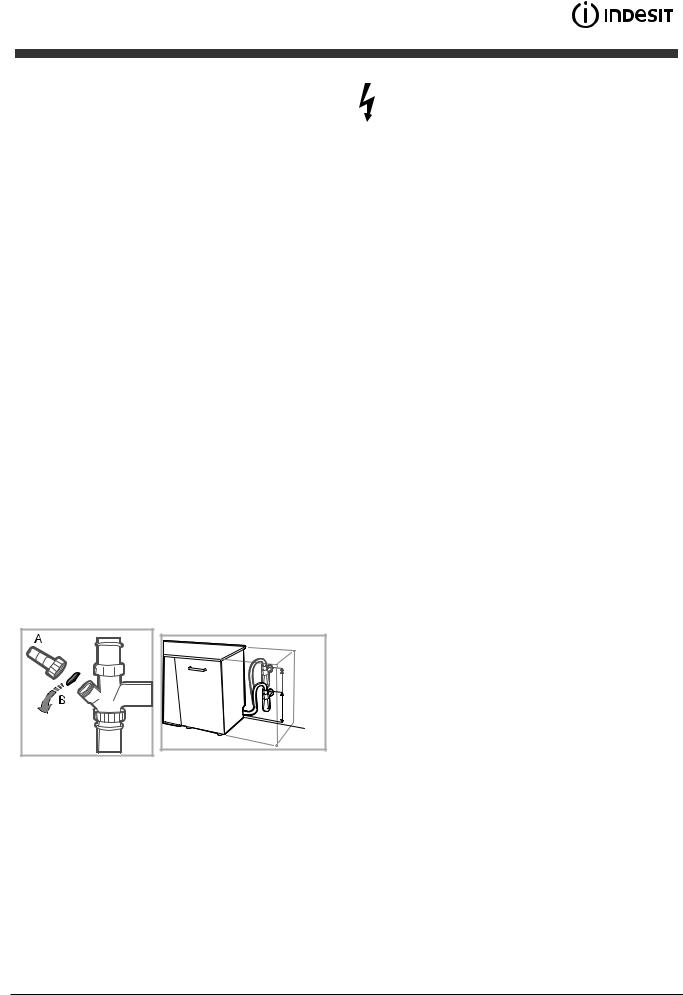
Installation
 If the appliance must be moved at any time, keep it in an upright position; if absolutely necessary, it may be tilted onto its back.
If the appliance must be moved at any time, keep it in an upright position; if absolutely necessary, it may be tilted onto its back.
Connecting the water supply
 Adaptation of the water supply for installation should only be performed by a qualified technician.
Adaptation of the water supply for installation should only be performed by a qualified technician.
The water inlet and outlet hoses may be positioned towards the right or the left in order to achieve the best possible installation.
Make sure the dishwasher does not bend or squash the hoses.
Connecting the water inlet hose
•To a 3/4” gas cold or hot water connection point (max. 60°C).
•Run the water until it is perfectly clear.
•Screw the inlet hose tightly into position and turn off the tap.
 If the inlet hose is not long enough, contact a specialist store or an authorised technician (see Assistance).
If the inlet hose is not long enough, contact a specialist store or an authorised technician (see Assistance).
 The water pressure must be within the values indicated in the Technical Data table - otherwise the dishwasher may be function properly.
The water pressure must be within the values indicated in the Technical Data table - otherwise the dishwasher may be function properly.
 Make sure the hose is not bent or compressed.
Make sure the hose is not bent or compressed.
Connecting the water outlet hose
Connect the outlet hose to a drain duct with a minimum diameter of 2 cm. (A)
The outlet hose connection must be at a height ranging from
40 to 80 cm from the floor or surface where the dishwasher
MAX 80 cm |
MIN 40 cm |
Before connecting the water outlet hose to the sink drain, remove the plastic plug (B).
Anti-flooding protection
To ensure floods do not occur, the dishwasher:
- is provided with a special system which blocks the water supply in the event of anomalies or leaks from inside the appliance.
Some models are also equipped with the supplementary safety device New Acqua Stop*, which guarantees antiflooding protection even in the event of a supply hose rupture.
WARNING: HAZARDOUS VOLTAGE! |
EN |
|
|
Under no circumstances should the water inlet hose be cut as it contains live electrical parts.
Electrical connection
Before inserting the plug into the electrical socket, make sure that:
•The socket is earthed and complies with current regulations;
•the socket can withstand the maximum load of the appliance as shown on the data plate located on the inside of the door
(see chapter Description of the appliance);
•The power supply voltage falls within the values indicated on the data plate on the inside of the door.
•The socket is compatible with the plug of the appliance. If this is not the case, ask an authorised technician to replace the plug (see Assistance). Do not use extension cables or multiple sockets.
 Once the appliance has been installed, the power supply cable and the electrical socket should be easily accessible.
Once the appliance has been installed, the power supply cable and the electrical socket should be easily accessible.
 The cable should not be bent or compressed.
The cable should not be bent or compressed.
 If the power supply cable is damaged, have it replaced by the manufacturer or its authorised Technical Assistance
If the power supply cable is damaged, have it replaced by the manufacturer or its authorised Technical Assistance
Service in order to prevent all potential hazards. (See
Assistance)
 The Company shall not be held responsible for any incidents, if these regulations are not observed.
The Company shall not be held responsible for any incidents, if these regulations are not observed.
Positioning and levelling
1.Position the dishwasher on a level sturdy floor. If the floor is uneven, the front feet of the appliance may be adjusted until it reaches a horizontal position. If the appliance is levelled correctly, it will be more stable and much less likely to move or cause vibrations and noise while it is operating.
2.Before recessing the dishwasher, stick the adhesive transparent strip* under the wooden shelf in order to protect it from any condensation which may form.
3.Place the dishwasher so that its sides or back panel are in contact with the adjacent cabinets or the wall. This appliance
can also be recessed under a single worktop* (see the
Assembly instruction sheet).
4*. To adjust the height of the rear foot, turn the red hexagonal bushing on the lower central part at the front of the dishwasher using a hexagonal spanner with an opening of 8 mm. Turn the spanner in a clockwise direction to increase the height and in an anticlockwise direction to decrease it. (see Building-in instruction sheet attached to the documentation)
* Only available in selected models.
13
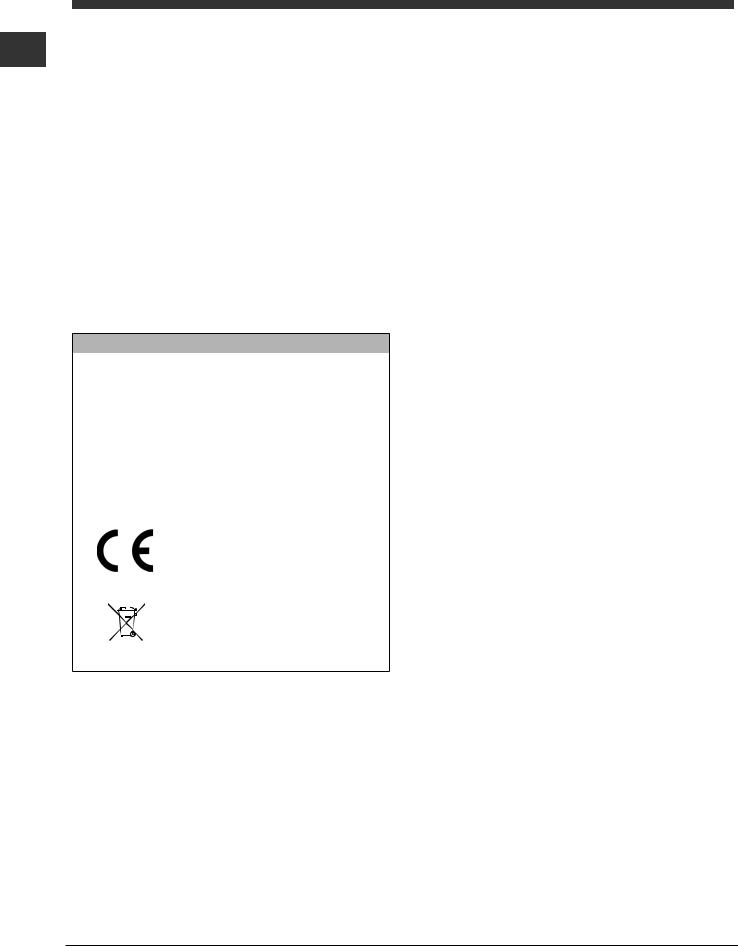
Advice regarding the first wash cycle
EN After the installation, remove the stoppers from the racks and the retaining elastic elements from the upper rack (if any).
Water softener settings
Before starting the first wash cycle, set the hardness level of the water from the mains supply. (see chapter Rinse aid and refined salt).
First load the softener tank with water, then introduce about
1 kg of salt. It is perfectly normal for water to flow out. As soon as this procedure is complete, run a wash cycle.
Only use salt that has been specifically designed for dishwashers.
After the salt has been poured into the machine, the LOW SALT indicator light* switches off.
 If the salt container is not filled, the water softener and the heating element may be damaged as a result.
If the salt container is not filled, the water softener and the heating element may be damaged as a result.
The machine has a buzzer/set of tones (depending on the dishwasher model) to inform the user that a command has been implemented: power on, cycle end etc.
The symbols/indicator lights/LEDs on the control panel/ display may vary in colour and may have a flashing or fixed light (depending on the dishwasher model).
The display* provides useful information concerning the type of wash cycle, drying/wash-cycle phase, remaining time, temperature etc.
Technical data
Dimensions |
width 44,5 cm |
||
height 82 cm |
|||
|
|
|
depth 55 cm |
Capacity |
10 standard place-settings |
||
Water supply pressure |
0,05 ÷ 1MPa (0.5 ÷ 10 bar) |
||
7,25 psi – 145 psi |
|||
Power supply voltage |
See appliance data plate |
||
|
|
|
|
Total absorbed power |
See appliance data plate |
||
|
|
|
|
Fuse |
See appliance data plate |
||
|
|
|
This dishwasher conforms to the |
|
|
|
following European Community |
|
|
|
Directives: |
|
|
|
-2006/95/EC (Low Voltage) |
|
|
|
-2004/108/EC (Electromagnetic |
|
|
|
Compatibility) |
|
|
|
-2009/125/EC (Comm. Reg. |
|
|
|
1016/2010) (Ecodesign) |
|
|
|
-97/17/EC (Labelling) |
|
|
|
-2012/19/ CE Waste Electrical |
|
|
|
|
|
|
|
and Electronic Equipment (WEEE) |
* Only available in selected models.
14

Description of the appliance
Overall view |
EN |
|
1.Upper rack
2. Upper spray arm
3. Tip-up compartments
4. Rack height adjuster
5. Lower rack
6.Lower spray arm
7. Cutlery basket
8. Washing filter
9. Salt dispenser
10. Detergent and rinse aid dispensers
11.Data plate
12. Control Panel***
Control panel
Select Wash |
Low Salt |
|
Cycle button |
indicator light |
Half Load Option button |
|
|
|
ON/OFF/RESET |
Wash-Cycle number |
|
button and |
and Remaining Time |
Multi-functional Tablets Option |
indicator light |
indicator |
button and indicator light (Tabs) |
|
|
|
|
|
|
|
|
|
|
|
|
|
|
|
|
|
|
|
|
|
|
|
|
|
|
|
|
|
|
|
|
|
|
|
|
|
|
|
|
|
|
|
|
|
|
|
|
|
|
|
|
|
|
|
|
|
|
|
|
|
|
|
|
|
|
Low Rinse Aid |
|
|
|
|
|
Delayed Start |
|||||
|
|
|
|
|
|
|||||||
|
indicator light |
|
|
|
|
|
Option button |
|||||
|
|
|
|
|
|
Half Load Option indicator lights |
||||||
|
|
|
|
Delayed Start Option |
||||||||
|
|
|
|
indicator light |
||||||||
***Only in completely built-in models. * Only available in selected models.
The number and type of wash cycles and options may vary depending on the dishwasher model.
15
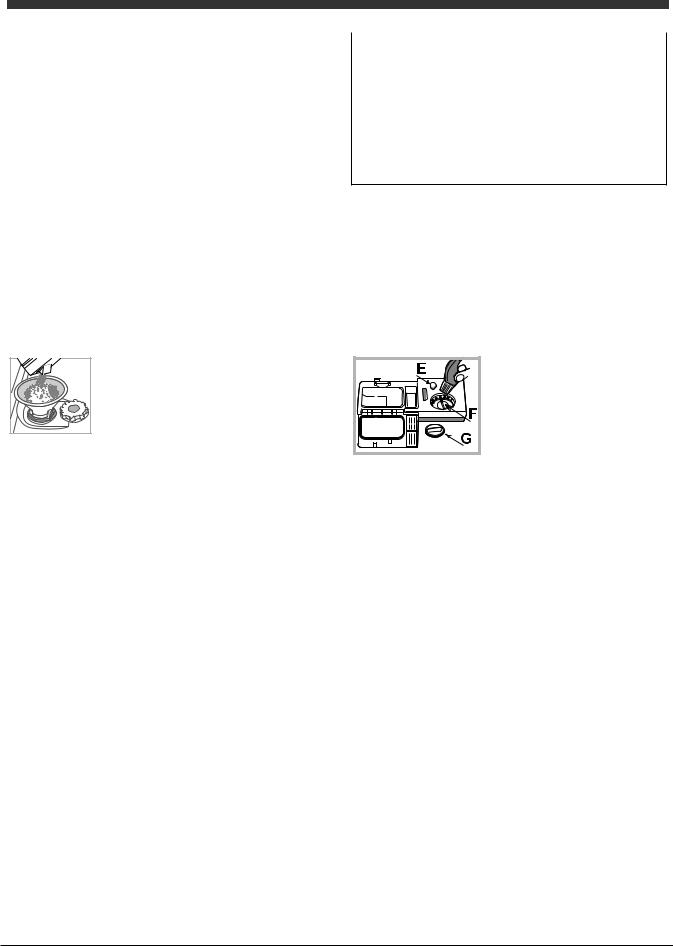
Refined Salt and Rinse Aid
EN |
|
|
Only use products which have been specifically designed |
|
|
||
|
for dishwashers. Do not use table salt or industrial salt. |
||
|
|
||
|
|
Follow the instructions given on the packaging. |
|
 If you are using a multi-function product, we recommend that you add salt in any case, especially if the water is hard or very hard. (Follow the instructions given on the packaging.)
If you are using a multi-function product, we recommend that you add salt in any case, especially if the water is hard or very hard. (Follow the instructions given on the packaging.)
 If you do not add salt or rinse aid, the LOW SALT* and LOW RINSE AID* indicator lights will remain lit.
If you do not add salt or rinse aid, the LOW SALT* and LOW RINSE AID* indicator lights will remain lit.
Measuring out the refined salt
The use of salt prevents the formation of LIMESCALE on the dishes and on the machine's functional components.
•It is important that the salt dispenser be never empty.
•It is important to set the water hardness.
The salt dispenser is located in the lower part of the dishwasher (see Description) and should be filled:
•When the LOW RINSE AID indicator light in the control panel is lit *;
•When the green float* on the cap of the salt dispenser is no longer visible.
•See autonomy in the water hardness table.
1. Remove the lower rack and unscrew the
container cap (anticlockwise).
2. Only the first time you do this: fill the water
dispenser up to the edge.
3. Position the funnel (see figure) and fill the salt container right up to its edge
(approximately 1 kg); it is not unusual for a little water to leak out. 4. Remove the funnel and wipe any salt residue away from the opening; rinse the cap under running water and then screw it on. It is advisable to perform this procedure every time you add salt to the container.
Make sure the cap is screwed on tightly, so that no detergent can get into the container during the wash cycle (this could damage the water softener beyond repair).
 Whenever you need to add salt, we recommend carrying out the procedure before the washing cycle is started.
Whenever you need to add salt, we recommend carrying out the procedure before the washing cycle is started.
Setting the water hardness
For perfect water softener operation, it is essential that the adjustment be based on the water hardness in your house. Ask your local water supplier for this information. The factory setting is for medium water hardness.
•Switch the dishwasher on using the On/Off button. 
•Switch it off using the On/Off button 
•Hold down button P for 5 seconds until you hear a beep.
•Switch it on using the On/Off button 
•The current selection level number and salt indicator light flash.
•Press button P to select the desired hardness level (see hardness table).
•Switch it off using the On/Off button 
•Setting is complete!
Water Hardness Table |
|
Average autonomy |
|||
|
salt dispenser with 1 |
||||
|
|
|
|
|
wash cycle per day |
level |
°dH |
°fH |
mmol/l |
months |
|
1 |
0 |
- 6 |
0 - 10 |
0 - 1 |
7 months |
2 |
6 - 11 |
11 - 20 |
1.1 - 2 |
5 months |
|
3 |
12 |
- 17 |
21 - 30 |
2.1 - 3 |
3 months |
4 |
17 |
- 34 |
31 - 60 |
3.1 - 6 |
2 months |
5* |
34 |
- 50 |
61 - 90 |
6.1 - 9 |
2/3 weeks |
For values between 0°f and 10°f, we do not recommend the use of salt. A setting of 5 may increase cycle duration.
(°dH = hardness measured in German degrees - °f = hardness measured in French degrees – mmol/l = millimoles per litre)
Measuring out the rinse aid
Rinse aid makes dish DRYING easier. The rinse aid dispenser should be filled:
•When the LOW RINSE AID indicator light on the panel/display is lit *;
•When the dark optical indicator on the dispenser door “E” becomes transparent.
1.Open the dispenser by turning
the cap "G" in an anticlockwise
direction.
2. Pour in the rinse aid, making
sure it does not overflow from the
dispenser. If this happens, clean
the spill immediately with a dry cloth.
3. Screw the cap back on.
NEVER pour the rinse aid directly into the tub.
Adjusting the amount of rinse aid
If you are not completely satisfied with the drying results, you can adjust the quantity of rinse aid used. Turn the adjuster “F”. A maximum of 4 levels can be set according to the dishwasher model. The factory setting is for a medium level.
•If you see bluish streaks on the dishes, set a low number (1-2).
•If there are drops of water or limescale marks on the dishes, set a high number (3-4).
* Only available in selected models.
16
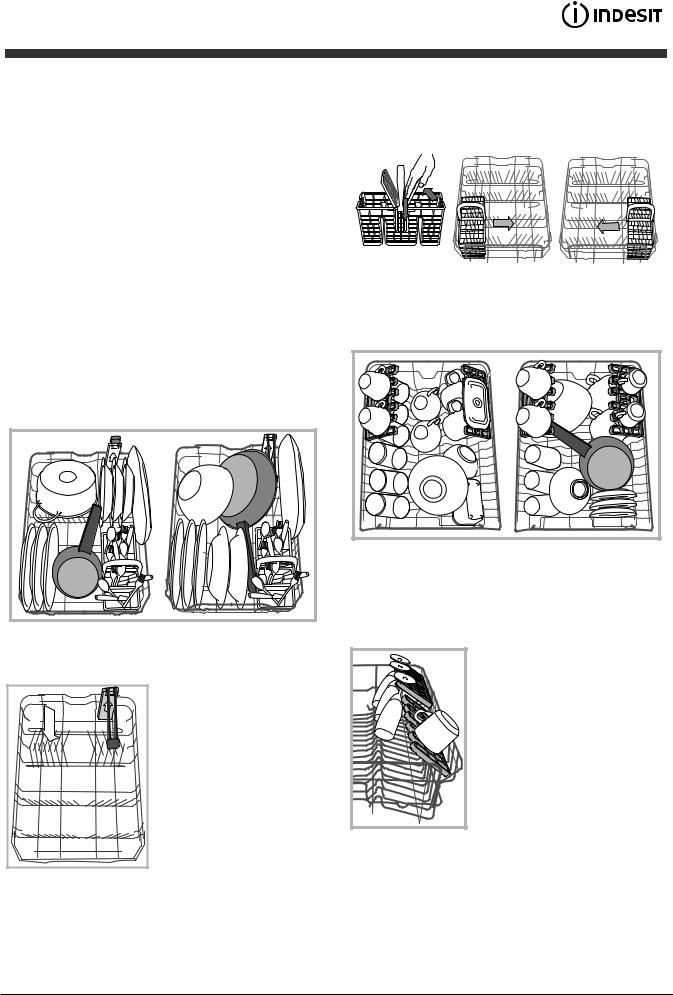
Loading the racks
Tips
Before loading the racks, remove all food residues from the crockery and empty liquids from glasses and containers. No preventive rinsing is needed under running water.
Arrange the crockery so that it is held in place firmly and does not tip over; and arrange the containers with the openings facing downwards and the concave/convex parts placed obliquely, thus allowing the water to reach every surface and flow freely. Make sure that the lids, handles, trays and frying pans do not prevent the spray arms from rotating. Place any small items in the cutlery basket.
Since plastic dishes and non-stick frying pans usually retain more water drops, their drying will be not so good as that of ceramic or stainless-steel dishes.
Lightweight items such as plastic containers should be placed in the upper rack and arranged so that they cannot move.
After loading the appliance, make sure that the spray arms can rotate freely.
Cutlery basket |
|
|||
EN |
||||
The basket is equipped with top grilles for improved cutlery |
||||
|
||||
arrangement. The cutlery basket should be positioned only at |
|
|||
the front of the lower rack. |
|
|||
|
|
|
|
|
|
|
|
|
|
Upper rack
Load this rack with delicate and lightweight crockery such as glasses, cups, saucers and shallow salad bowls.
Lower rack
The lower rack can hold pans, lids, dishes, salad bowls, cutlery etc. Large plates and lids should ideally be placed at the sides.
Very soiled dishes and pans should be placed in the lower rack because in this sector the water sprays are stronger and allow a higher washing performance.
Several dishwasher models are fitted with tip-up sectors*.
They can be used in a vertical position when arranging dishes or
in a horizontal position (lower) to load pans and salad bowls easily.
Some models are equipped with Vertical Zone, special pull-out supports*in the rear of the rack that can be used to support frying pans and baking pans in a more vertical position, thus taking up less space.
In order to use it, just get hold of the coloured grip and pull it upwards while rotating it forward. The supports can slide right and left to fit the size of the crockery.
Adjustable position tip-up compartments*
The side tip-up compartments can be positioned at three different heights to optimize the arrangement of the crockery inside the rack.
Wine glasses can be placed safely in the tip-up compartments by inserting the stem of each glass into the corresponding slot.
For optimum drying results incline the tip-up compartments more. To change the inclination, pull up the tip-up compartment, slide it slightly and position it as you wish.
*Only available in selected models with different numbers and positions.
17
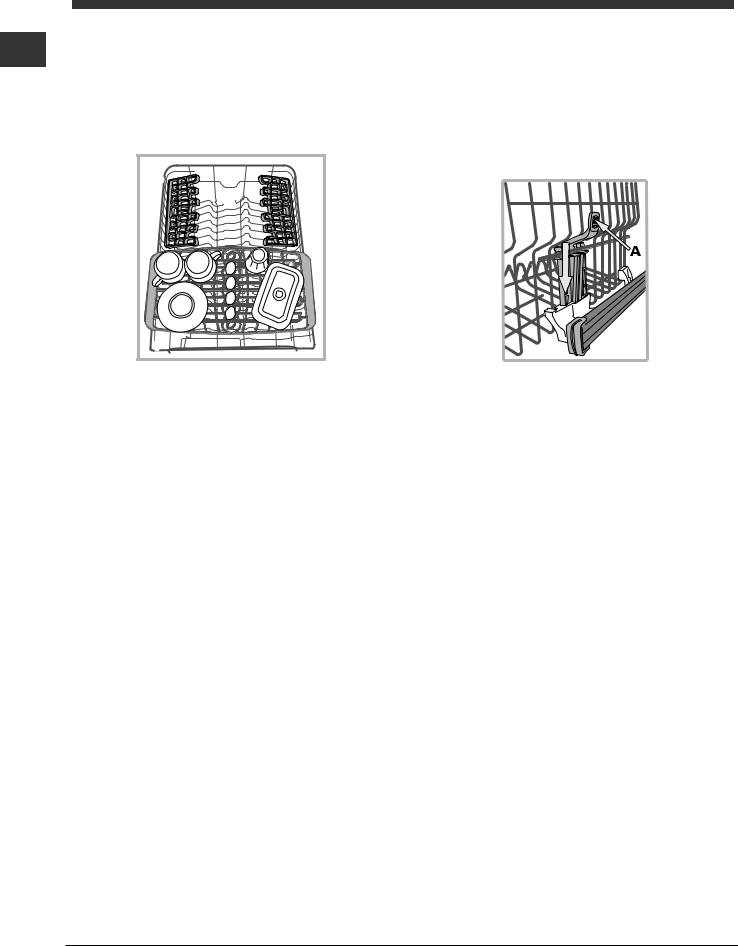
EN Tray*
Some dishwasher models are fitted with a sliding tray which can be used to hold small crockery and cutlery.
For optimum washing performance, avoid positioning bulky crockery directly below the tray. The cutlery tray can be removed (see Figure.)
*Only available in selected models with different numbers and positions.
Adjusting the height of the upper rack
The height of the upper rack can be adjusted: high position to place bulky crockery in the lower rack and low position to make the most of the tip-up compartments by creating more space upwards.
The height of the upper rack should be adjusted WHEN THE RACK IS EMPTY.
NEVER raise or lower the rack on one side only.
If the rack is equipped with a Lift-Up device* (see figure), lift it up by holding its sides. To restore the lower position, press the levers (A) at the sides of the rack and follow the rack down.
Unsuitable crockery
•Wooden crockery and cutlery.
•Delicate decorated glasses, artistic handicraft and antique crockery. Their decorations are not resistant.
•Parts in synthetic material which do not withstand high temperatures.
•Copper and tin crockery.
•Crockery soiled with ash, wax, lubricating grease or ink.
The colours of glass decorations and aluminium/silver pieces can change and fade during the washing process. Some types of glass (e.g. crystal objects) can become opaque after a number
of wash cycles too.
Damage to glass and crockery
Caused by:
•Type of glass and glass production process.
•Chemical composition of detergent.
•Water temperature of rinse cycle.
Tips:
•Only use glasses and porcelain guaranteed by the manufacturer as dishwasher safe.
•Use a delicate detergent suitable for crockery.
•Collect glasses and cutlery from the dishwasher as soon as the wash cycle is over.
18
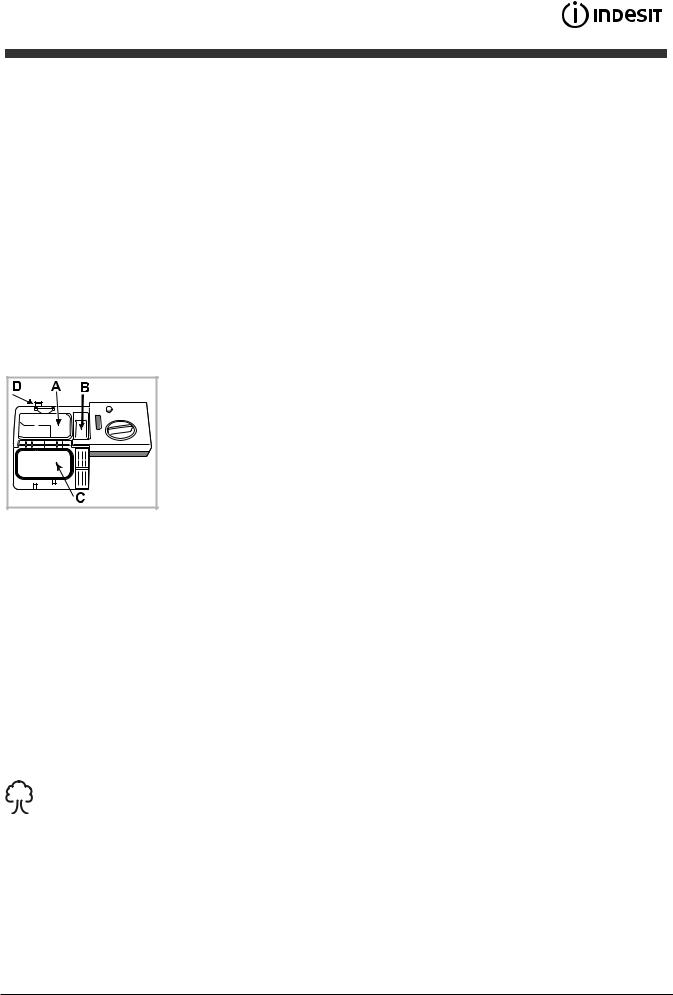
Detergent and dishwasher use
Measuring out the detergent
Good washing results also depend on the correct amount of detergent being used. Exceeding the stated amount does not result in a more effective wash and increases environmental pollution.
The amount can be adjusted to the soil level.
In the case of normally soiled items, use approximately either 25g (powder detergent) or 25ml (liquid detergent). If tablets are used, one tablet will be enough.
If the crockery is only lightly soiled or if it has been rinsed with water before being placed in the dishwasher, reduce the amount of detergent used accordingly.
For good washing results also follow the instructions shown on the detergent box.
For further questions please ask the detergent producers.
Open the detergent dispenser using button D and measure out the detergent according to the Table of wash cycles:
• p o w d e r o r l i q u i d : c o m p a r t m e n t s A ( w a s h
detergent) and B (pre-wash
detergent)
• tablets: when the cycle requires 1 tablet, place it in
compartment A and close cover C; when it requires 2
tablets, place the second tablet on the bottom of the appliance.
Remove detergent residues from the edges of the compartment and close cover C until it clicks.
The detergent dispenser automatically opens up at the right time according to the wash cycle.
If all-in-one detergents are used, we recommend using the TABS option, because it adjusts the cycle so that the best washing and drying results are always achieved.
 Only use detergent which has been specifically designed for dishwashers.
Only use detergent which has been specifically designed for dishwashers.
DO NOT USE washing up liquid.
Using excessive detergent may result in foam residues remaining in the machine after the cycle has ended.
To achieve the best washing and drying results, the combined use of detergent, rinse aid liquid and refined salt is required.
We recommend using detergents that do not contain phosphates or chlorine, as these products are harmful to the environment.
* Only available in selected models.
Starting the dishwasher |
|
||
EN |
|||
1. |
Turn the water tap on. |
||
|
|||
2. |
Open the door and press ON-OFF button. |
|
|
3. |
Measure out the detergent. (see detergent information). |
|
|
4. |
Load the racks (see Loading the racks). |
|
|
5. Select the wash cycle in accordance with the type of crockery and its soil level (see table of wash cycles) by pressing the P button.
6.Select the wash options*. (see Special wash cycles and options).
7.Start the wash cycle by shutting the door.
8.The end of the wash cycle is indicated by beeps and by the flashing of the wash cycle number on the display. Open the door, switch off the appliance by pressing the ON/OFF button.
9.Wait for a few minutes before removing the crockery, in order to avoid burns. Unload the racks, beginning with the lower level.
 - The machine will switch off automatically during certain extended periods of inactivity, in order to minimise electricity consumption.
- The machine will switch off automatically during certain extended periods of inactivity, in order to minimise electricity consumption.
 AUTO WASH CYCLES*:some models of dishwashers are equipped with a special sensor which can be used to assess the level of soiling and automatically setting the most efficient and economic wash cycle accordingly.
AUTO WASH CYCLES*:some models of dishwashers are equipped with a special sensor which can be used to assess the level of soiling and automatically setting the most efficient and economic wash cycle accordingly.
The duration of the Auto wash cycles may vary due to the operation of the sensor.
 If the crockery is only lightly soiled or if it has been rinsed with water before being placed in the dishwasher, reduce the amount of detergent used accordingly.
If the crockery is only lightly soiled or if it has been rinsed with water before being placed in the dishwasher, reduce the amount of detergent used accordingly.
Modifying a wash cycle in progress
If a mistake was made during the wash cycle selection process, it is possible to change the cycle, provided that it has only just begun: open the door taking care to avoid the escaping steam, by pressing and holding the ON/OFF button, the machine will switch off. Switch the machine back on using the ON/OFF button and select the new wash cycle and any options desired; start the cycle by closing the door.
Adding extra crockery
Without switching off the machine, open the door, taking care to avoid the escaping steam, and place the crockery inside the dishwasher. Shut the door and the cycle will begin from the point at which it was interrupted.
Accidental interruptions
If the door is opened during the wash cycle, or if there is a power cut, the cycle stops. It starts again from the point at which it was interrupted once the door has been shut or the electricity supply is restored.
19

Wash cycles
Wash-cycle data is measured under laboratory conditions according to European Standard EN 50242.
EN Based on the different conditions of use, the wash-cycle duration and data can change.
 The number and type of wash cycles and options may vary depending on the dishwasher model.
The number and type of wash cycles and options may vary depending on the dishwasher model.
|
Wash cycle |
|
Approximate |
Water |
Energy |
|
|
which |
|
duration of wash |
|||
Wash cycle |
Options |
consumption |
consumption |
|||
include |
cycles |
|||||
|
|
(l/cycle) |
(kWh/cycle) |
|||
|
drying |
|
h:min. |
|||
|
|
|
|
|||
1. Eco |
Yes |
Delayed start – |
03:00’ |
9,0 |
0,74 |
|
Half Load - Tabs |
||||||
|
|
|
|
|
||
|
|
|
|
|
|
|
2. Auto Intensive |
Yes |
Delayed start – |
02:20’ - 03:00’ |
13,0 - 14,0 |
1,20 - 1,40 |
|
Half Load - Tabs |
||||||
|
|
|
|
|
||
|
|
|
|
|
|
|
3. Auto Normal |
Yes |
Delayed start – |
01:40’ - 02:20’ |
13,5 – 14,5 |
1,00 - 1,15 |
|
Half Load - Tabs |
||||||
|
|
|
|
|
||
|
|
|
|
|
|
|
4. Daily |
No |
Delayed start – |
01:00’ |
13,0 |
0,95 |
|
Half Load - Tabs |
||||||
|
|
|
|
|
||
|
|
|
|
|
|
|
5. Delicates |
Yes |
Delayed start – |
01:40’ |
9,0 |
0,85 |
|
Half Load - Tabs |
||||||
|
|
|
|
|
||
|
|
|
|
|
|
|
6. Express |
No |
Delayed start – Tabs |
00:25’ |
8,0 |
0,45 |
|
|
|
|
|
|
|
|
7. Prewash |
No |
Delayed start – |
00:10’ |
4,0 |
0,01 |
|
Half Load |
||||||
|
|
|
|
|
||
|
|
|
|
|
|
Instructions on wash-cycle selection and detergent dosage
1.The ECO wash cycle is the standard cycle to which the energy label data refers. It can be used to wash crockery with a normal soil level and is the most efficient cycle in terms of energy and water consumption for this type of crockery.
4 gr/ml**+ 21 gr/ml – 1 Tab (**Quantity of pre-washing detergent)
2.Heavily soiled dishes and pans (not to be used for delicate items). 25 gr/ml – 1 Tab
3.Normally soiled pans and dishes. 4 gr/ml**+ 21 gr/ml – 1 Tab
4.Limited quantity of daily soiling (ideal for 4 place settings) 25 gr/ml – 1 Tab
5.Cycle for delicate items, which are more sensitive to high temperatures 25 gr/ml – 1 Tab
6.Fast cycle to be used for slightly dirty dishes (ideal for 2 place settings) 21 gr/ml – 1 Tab
7.Pre-wash while awaiting completion of the load with the dishes from the next meal. No detergent.
Standby consumption: Left-on mode consumption: 5 W - Off mode consumption: 0.5 W.
20

Special wash cycles and Options
Notes:
Optimum performance levels when using the “Daily" and "Express” cycles can be achieved by respecting the specified number of place settings.
To reduce consumption even further, only run the dishwasher when it is full.
Note for Test Laboratories: for information on comparative
EN testing conditions, please send an email to the following address: assistenza_en_lvs@indesitcompany.com
Wash options*
If an option is not compatible with the selected wash cycle (see table of wash cycles), the corresponding LED flashes rapidly 3 times and beeps will sound.
Delayed start Option
The start of the wash cycle may be delayed for a period of time between 1 and 12 hours.
1.Press the DELAYED START button: the corresponding symbol appears on the display; each time you press the button, the time
(1h, 2h, etc. up to max. 12h) from the start of the selected wash cycle will be increased.
2.Select the cycle and close the door: the timer will begin counting down;
3.Once this time has elapsed, the indicator light switches off and the wash cycle begins.
To adjust the delay time and select a smaller period of time, press the DELAYED START button. To cancel it, press the button repeatedly until the selected delayed start indicator light switches off. The wash cycle will start automatically as soon as
the door is shut.
 The Delayed Start function cannot be set once a wash cycle has started.
The Delayed Start function cannot be set once a wash cycle has started.
Half load Option using the upper or lower |
EN |
|
rack |
||
|
If there are not many dishes to be washed, a half load cycle may be used in order to save water, electricity and detergent.
Select the wash cycle and then press the HALF LOAD button: the indicator corresponding to the chosen rack lights up and the wash cycle starts only in the upper or lower rack.
 Remember to load the upper or lower rack only, and to reduce the amount of detergent accordingly.
Remember to load the upper or lower rack only, and to reduce the amount of detergent accordingly.
Multi-functional tablets Option (Tabs)
This option optimises washing and drying results.
When using multi-functional tablets, press the MULTIFUNCTIONAL TABLETS button; the corresponding symbol will light up. If the button is pressed again, the option will be deselected.
 The “Multi-functional tablets” option results in a longer wash cycle.
The “Multi-functional tablets” option results in a longer wash cycle.
* Only available in selected models.
21
